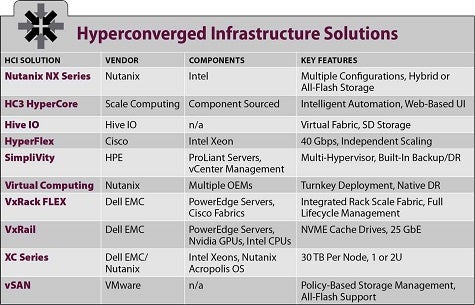In enterprise circles, much of the talk regarding converged infrastructure (CI) and hyperconverged infrastructure (HCI) centers on which approach is appropriate for a given use case.
HCI, of course, has the benefit of massive modularization, which enables rapid deployment and fairly easy maintenance and support, while CI offers a more gradual transition from traditional infrastructure and, for the moment at least, somewhat more flexibility when it comes to scale.
Nutanix is credited with launching the HCI movement, and its executives contend that the choice between CI and HCI is a false one. Mike Wronski, senior product marketing manager, argues that emerging HCI platforms are quickly erasing CI’s primary advantage – the ability to scale compute, storage and other components independently from one another – by offering modules that provide different levels of each resource.
“Even if you are adding some compute or storage, you can still scale in incremental units,” he said. “An appliance can be compute heavy, with little storage, or vice versa.”
In this way, he says, organizations gain the speed of deployment, a more streamlined architecture and a fully software-defined data environment while retaining the ability to craft finely tailored infrastructure that suits strategic business objectives.
Still, doesn’t CI provide a smoother upgrade path to full HCI later? Perhaps, says Wronski, but its benefits are limited to the initial deployment, not ongoing operations.
“There is much less of a break between traditional and converged infrastructure,” he said. “Basic convergence solves a zero-day installation problem in that it is easy to buy new gear. But it doesn’t solve Day 1 management issues, upgrades, expansion… HCI addresses the whole thing, from Day 1 on.”
So, does this mean the enterprise needs to convert to full HCI as quickly as possible? Not necessarily, says Wronski. Abrupt change can be difficult to manage, particularly when it comes to critical applications and services, so most HCI deployments will likely start small and expand over time.
“With any new technology, the enterprise likes to dip a toe in and validate it for themselves,” he said. “HCI works because it is not a wholesale change. The hardware refresh is a great time to change architectures, but you’ll need to get experience before going all in.”
Ultimately, of course, the goal of HCI is to produce a streamlined, small-footprint infrastructure that can support cloud-like resource federation for all users, all while supporting hot-swappable hardware components that can be replaced with no disruption to operations and with very little technical knowledge. For organizations looking to shed the burdens of infrastructure management to focus on more strategic data objectives, there is little reason to stick with the complicated, hardware-defined infrastructure of the past.
Below are some of the leading hyperconverged infrastructure solutions:
Nutanix NX Series
The NX Series comes in a range of models, each with variable configuration options built on a 2 RU form factor. Systems are built around Intel Broadwell or Skylake processors, with storage scaling into the petabytes. Top-end systems support 25 and 40 GbE connectivity on either SFP+ or QSFP+ cabling.
HC3 HyperCore, Scale Computing
The HC3 hardware platform driven by HyperCore management software is designed to provide high availability and scale across private cloud architectures. The system offers integrated hypervisor support with live VM migration, as well as software-define hybrid storage with direct block-access data pathways.
HiveIO
HiveIO is the off-shoot of Atlantis Computing’s former HCI unit, which it purchased in 2017. The platform consists of the Hive Fabric virtualization infrastructure stack and the USX intelligent SDS solution. The company claims it can deliver the lowest-cost virtual server and desktop infrastructure platform on the market, offering a next-gen data solution either on-premises or in a hybrid cloud architecture.
HyperFlex, Cisco
HyperFlex is built on Cisco’s UCS platform and the HX software stack that grew out of the company’s acquisition of Springpath. The system is designed for multicloud services and simplified container deployment, while at the same time providing streamlined deployment of Microsoft platforms like Hyper-V, XenDesktop and SQL.
SimpliVity, HPE
SimpliVity offers a policy-based VM management stack for seamless data mobility and proactive resource utilization. It also provides always-on compression and dedupe, as well as bandwidth-efficient replication. The company claims the platform can deliver a 52:1 reduction in storage, a 69 percent reduction in TCO and a 50 percent productivity boost.
Virtual Computing, Nutanix
Nutanix strives for simplicity in design, deployment and operation. Its platform is hypervisor agnostic and offers tools like live VM migration, high availability and distributed resource scheduling. Each 2U appliance holds up to four nodes with local storage and server-attached flash. The system also provides seamless, linear scalability for improved data center planning.
VxRack FLEX, Dell EMC
VxRack FLEX incorporates the latest PowerEdge servers and Cisco rack-scale spine-leaf fabric technology to deliver a 2.5X IOPS increase and a 30 percent lower TCO. The system supports hybrid cloud and software-defined architectures to improve workload flexibility.
VxRail, Dell EMC
VxRail is available in a wide range of configurations, from general-purpose devices to specialized core, edge and storage-facing designs. New to the portfolio is the security technical implementation guide (STIG) that automates the security hardening process across storage, virtualization and networking infrastructure.
XC Series, Dell EMC/Nutanix
The XC Series can be preconfigured for specific virtualized workloads and can preserve data availability in the event of disk or even full node failure. The system supports policy-based management of virtual environments rather than traditional LUN, volumes or RAID groups, while also enabling storage aggregation across nodes with thin-provisioning, compression and other features to manage capacity.
vSAN, VMWare
vSAN is available in multiple editions, ranging from standard, advanced and enterprise versions to specialized releases targeting remote/branch offices and VDI. All-flash versions deliver up to 150K IOPS per node for Oracle, Exchange, SAP and other critical workloads, while integration with other VMware products enable functions like replication, DR and orchestration.

Arthur Cole writes about infrastructure for IT Business Edge. Cole has been covering the high-tech media and computing industries for more than 20 years, having served as editor of TV Technology, Video Technology News, Internet News and Multimedia Weekly. His contributions have appeared in Communications Today and Enterprise Networking Planet and as web content for numerous high-tech clients like TwinStrata and Carpathia. Follow Art on Twitter @acole602.









